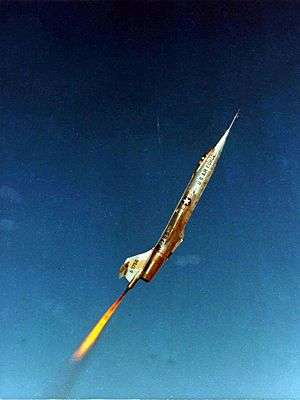Zoom climb

A zoom climb is a climb where the rate of climb is greater than the maximum for a sustained climb, as determined from the thrust of the aircraft's engines. Before a zoom climb, the aircraft accelerates to a high air speed at an altitude at which it can operate in sustained level flight. The pilot then pulls steeply upward, trading the kinetic energy of forward motion for altitude. During these maneuvers the engine is in full thrust. The aircraft gains potential energy (altitude) at the expense of kinetic energy (forward motion). This is different from a steady climb, where the increase in potential energy comes from mechanical work done by the engines, rather than from the aircraft's kinetic energy.
In a demonstration of their performance, English Electric Lightning fighter aircraft have sometimes used zoom climbs to climb above a Lockheed U-2 (which cruises at an altitude above the Lightning's service ceiling), before pouncing on it from above.[1]
During the Second World War, MiG-3 pilots utilized zoom climbs and subsequent descents to maintain a speed advantage over German fighters.
Zoom climbs have been used to test new aircraft designs and conduct research in different flight regimes.[2] During the proving phase of the McDonnell Douglas F-4 Phantom II, on December 6, 1959, an early version of the aircraft (the XF4H-1) performed a zoom climb to a world record 98,557 feet (30,040 m) as part of Operation `Top Flight'. The previous record of 94,658 feet (28,852 m) was set by a Soviet Sukhoi T-43-1 prototype. Commander Lawrence E. Flint Jr. accelerated his aircraft to Mach 2.5 at 47,000 feet (14,330 m) and climbed to 90,000 feet (27,430 m) at a 45-degree angle. He then shut down the engines and glided to the peak altitude. As the aircraft fell through 70,000 feet (21,300 m), Flint restarted the engines and resumed normal flight.
An NF-104A Starfighter fitted with an additional rocket engine was also regularly used in zoom climb research for future spaceflight. On May 7, 1958, the aircraft reached an altitude of 91,249 feet (27.81 km) in a zoom climb at Edwards Air Force Base, Calif., setting a new altitude record. The Mach 2 mission took the airplane so high that the standard F-104’s jet engines routinely exceeded their temperature limits and had to be shut down. Sometimes the engine simply flamed out for lack of air. Then the pilot steered the aircraft like a returning spaceship to a lower altitude, where he would restart the engine.
It was on one such "zoom climb" flight that test pilot Chuck Yeager was nearly killed flying a heavily modified F-104 on December 10, 1963.[3]
On 25 July 1973, A. Fedotov reached 35,230m (115,600 feet) in a Mikoyan-Gurevich MiG-25 with 1,000 kg payload, and 36,240 m (118,900 feet) with no load (an absolute world record).[4][5] In the thin air, the engines flamed out and the aircraft coasted in a ballistic trajectory by inertia alone. At the apex the speed had dropped to 75 km/h.
Without engine power, the cockpit would depressurize on these missions. Consequently, for protection against the rarified atmosphere, the pilot wore a full-body pressure suit. Properly outfitted with an airtight helmet and suit the pilot received breathing oxygen without ill effects.
See also
References
- ↑ Ross, Charles (October 2004). "October 2004 Archive Story: Lightning vs Concorde". English Electric Lightning Site. Retrieved 2 January 2013.
- ↑ Zoom Climb, Air Force Magazine 88 (February 2005)
- ↑ "The Crash of Chuck Yeager's NF-104A". Check-Six.com. Retrieved 10 April 2013.
- ↑ Belyakov and Marmain 1994, p. 392.
- ↑ FAI Record
